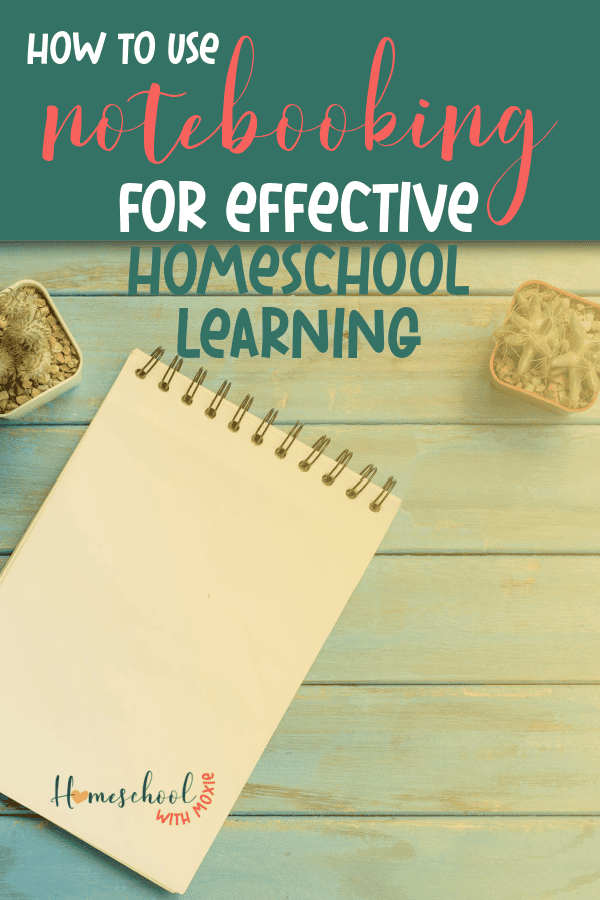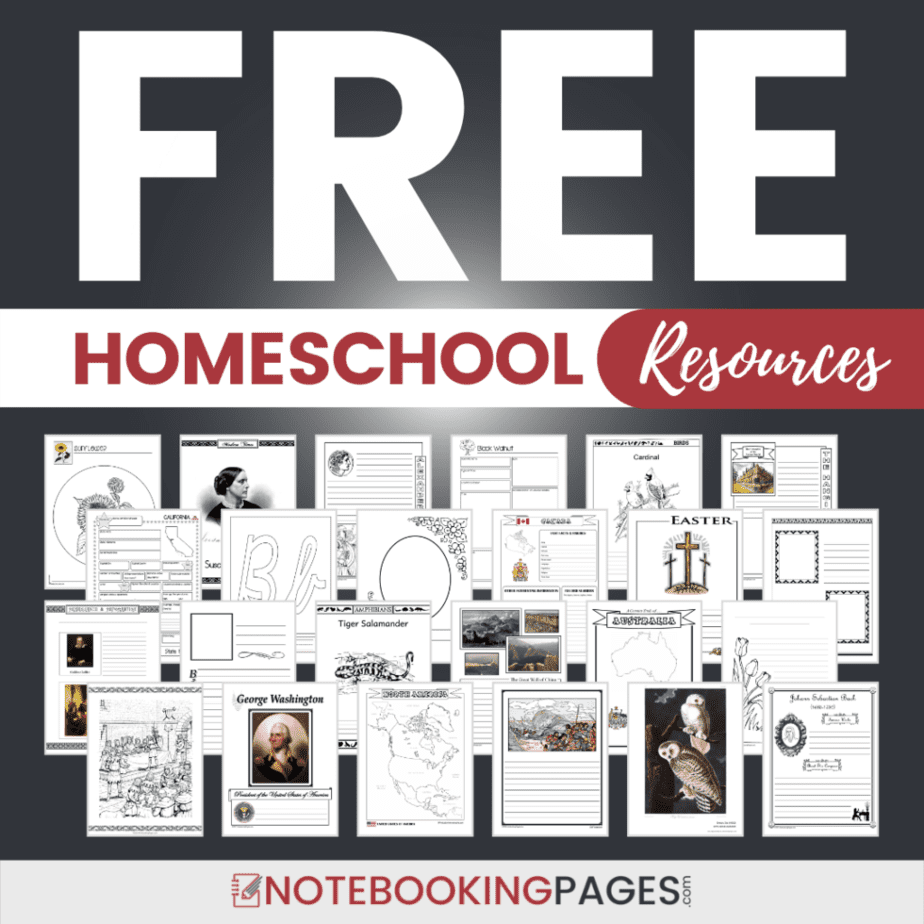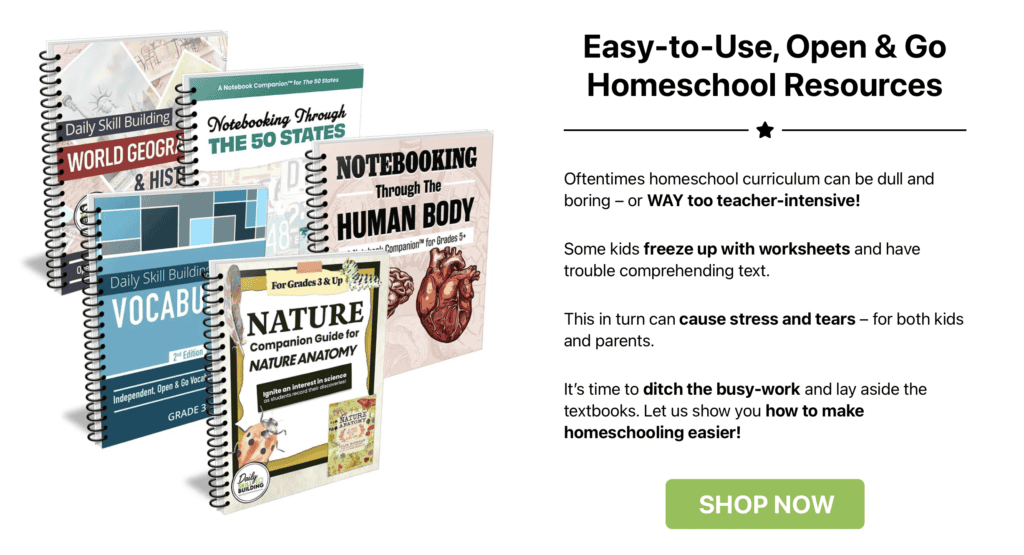Notebooking is an effective method to use in your homeschool for active learning that also allows for creativity and individualized content. It’s a versatile tool for your homeschool toolbox, especially if you want to teach multiple kids at once! Here’s a brief overview of homeschool notebooking plus actionable strategies for implementing it in your homeschool.

This post contains affiliate links.
What is Notebooking?
You can think of notebooking as an ever-changing collection of your student’s work in a given subject. It’s like a big fun scrapbook of their learning!
It can take any form you want. Your artistic child might sketch diagrams and maps for many assignments. The linguistic child might love to create historical diary entries or persuasive essays about history topics. Your scientific child might love to include sketches from nature walks or weather stats from the week.
The best part is – there are no rules for notebooking! It’s like homeschooling in that it is customizable, DIY, and can fit your child.
So, the dyslexic kid who struggles with writing? Don’t force it! Include more pictures, diagrams, or sketches if that’s easier to communicate what he’s learned.
Your first grader’s notebooking product will look much different than his sibling’s notebook for sixth grade.
The beauty of notebooking is that you can use it for all your kids while teaching multiple ages together.
The supplies are simple too, which is great. The best option is to grab a 3-ring binder for each kid, and lots of lined or blank paper to insert. Colored pencils or pens is also fun!
Then, for each subject, you need your content. This could be in the form of a textbook, subject-specific encyclopedia (like an Usborne Science Encyclopedia), atlas, videos, or other “spine.”
Once you read or listen to the content for the lesson, you and your child can decide on the “response” to the content, which gets included in the notebook.
Are they going to write a narration about the history lesson? Maybe draw a mini timeline of events?
For science, they might sketch different plant leaves and label them. Or, draw a diagram of the water cycle.
Foreign language might include learning the names of colors today, so they could write “red” then “rouge” and then finally color a splash of red next to the labels.
Can you see how notebooking engages your child as an active learner? Contrast this active learning posture with the traditional worksheet approach. The traditional approach with low-level worksheets produces a passive learner at best and a frustrated learner at worst.
Benefits of Notebooking in Homeschool
We’ve already mentioned what I think may be the biggest benefit of using notebooking in your homeschool – and that is engaging your student actively! Because students have to analyze, interpret, summarize, and record their own information, they are actively engaged in the learning process. They’re basically creating their own learning resources in the way that makes the most sense for their learning style.
And this brings us to another huge benefit: notebooking develops critical thinking skills. Instead of asking your child to fill out simple fact-based worksheets, they have to use higher order thinking skills to interact with the content. With notebooking, your child’s understanding of the information deepens as they summarize and organize it, whether by diagram, drawing, outlines, or sentences.
But your creative students will benefit from notebooking too! In fact, notebooking helps foster creativity and personal expression. Students enjoy being able to personalize their notebooks with illustrations, diagrams, or even creative writing.
Remember Mrs. Frizzle and the Magic School Bus? If your child learns best with creative adventures like this, they can turn their notebooking into their own adventure book. Or, your logical learner may rather have an organized and non-colored up notebook where they record all the data and information they want to remember. In other words, notebooking is flexible enough for all learners.
Did you know that the process of writing by hand helps to solidify knowledge? The more senses you can engage in learning, the better the information retention. So, instead of just filling out a low-level worksheet, when your child needs to consult a library book, reproduce and label a diagram, analyze and summarize information, and then record that all by hand in a notebook – your child is more likely to remember what they’ve learned.
Finally, in addition to being a flexible tool to use for all different learning styles (check out episode 282 of the Homeschool with Moxie Podcast below for a recap of that!), notebooking can be used with various subjects and with multiple ages. It’s a great tool in a homeschool parent’s toolbox for help in simplifying the teaching of multiple ages together.
How Can You Use it in Your Homeschool?
We’ve used notebooking over the years for history, science, Bible, and foreign language. It’s well-suited for teaching multiple ages together, as you can customize the requirements for each grade level.
The youngest kids might draw a picture and write one sentence. The older kids might be required to label a diagram and write a paragraph.
It’s also a thrifty homeschooling method, as you don’t need to purchase expensive workbooks or work texts for each child. Just use the spine of your choice (history book, science encyclopedia, foreign language videos) and then the written component of the course take the form of creative notebooking pages.
You definitely can purchase pre-made notebooking pages, but sometimes the best option can be to help your kids create custom pages as they go.
Each assignment will have a different spin on it and need a different type of notebooking page.
Here are some ideas:
- timeline
- diagram with labels
- map
- list
- biographical content
- plot structure
- pictures & words (foreign language)
- illustrations and short captions (from your Bible reading or history lesson)
There really are thousands of different things you can include in your notebooking routine! It’s a fun way to capture all the different things your child is learning in a subject.
How to Get Started with Notebooking
First, you’ll need to gather your materials. What is your primary information source – a textbook, living book, video, listening to a lesson read aloud, science experiment, nature walk? You’ll also need a few simple supplies. Will you use a spiral notebook or a 3-ring binder with loose-leaf paper? Will your child create their own page or use a notebooking page template? There’s no right way to do it! Do what works best for you and your kids.
Next, figure out which subjects you want to use for notebooking. You can do this with just about any subject, but the ones that work well include science, history, Bible, and literature. The great thing is that multiple ages can use notebooking while you teach these subjects together. If notebooking is new for you, just start with one or two subjects to avoid overwhelm.
Finally, set clear expectations and guidelines. You may need to show your child some example notebooking pages, or complete a few with them for a history or science lesson so they see what’s possible. You can scaffold the help. That may look like writing down a few key names or terms for the history lesson that you want them to include on their notebooking page. They may still have the creative license to document their learning, but your expectation can be that they will include those key data points. This is one way that you can differentiate the notebooking expectations for a third grader versus a seventh grader.
If you’re already using narration in your homeschool, you can take oral narration to the next level and ask your children to include a written narration in their notebooking.
And the final best piece of advice? Just do it! The more you do it, the easier it will be!
Notebooking Techniques and Ideas for Different Subjects
Notebooking allows you to homeschool out of the box! There is no right answer for how to do notebooking. But if you want some inspiration, take a look at various ideas depending on the subject matter.
- History: Creating timelines, summarizing key events, drawing maps.
- Science: Recording experiments, illustrating observations, writing reports.
- Literature: Character profiles, book summaries, personal reflections.
- Geography: Drawing maps, labeling countries, journaling about different cultures.
HWM 156: How to Make Any Curriculum Work for Any Child
Listen in to this episode of the Homeschool with Moxie Podcast to learn how to make any curriculum work for any child.
Learn how narration and notebooking will allow you to:
- teach multiple ages together
- use any resource as your “curriculum” – even FREE library books!
- simplify your homeschooling
- engage your kids with active learning
HWM 282. The Power of Notebooking: How This Simple Tool Transforms Homeschool Learning
On episode 282 of the Homeschool with Moxie Podcast, we’ll start with a 30,000 foot overview of why notebooking works for kids with various learning styles.
If you’re looking for a flexible, creative way to enhance your homeschool curriculum, notebooking might be the perfect solution. This simple yet powerful method encourages students to explore topics deeply while organizing their thoughts in a personalized format. And notebooking is effective for all learning styles! From science experiments to history lessons, notebooking allows children to take ownership of their learning, making the process more engaging and meaningful.
HWM 283. Notebooking Strategies for Homeschoolers: Practical Tips for Success
In this episode, we focus on practical, hands-on strategies for homeschoolers to implement notebooking effectively. Discover how to set up your notebooks for different subjects, use creative layouts, and make notebooking a daily habit that strengthens learning. Whether you’re new to homeschooling or looking to add variety to your lessons, these actionable tips will help you integrate notebooking into your homeschool routine.
Two top tips for notebooking success:
- Notebooking is best used in content subjects like history and science
- Narration is a key foundational skill to learn along with (or before) you start notebooking.

